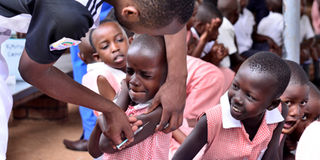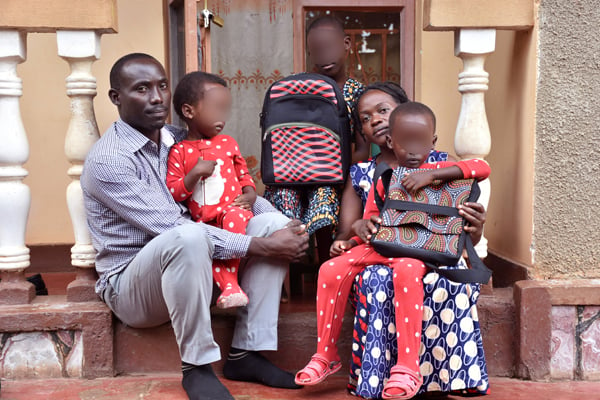Pneumonia vaccine cuts deaths in children by half

A pupil of Kitante Primary School in Kampala receives a measles, rubella and polio vaccine during the nationwide immunisation campaign on October 16, 2019. PHOTO / FILE
What you need to know:
- About 65 children under five years were dying every day due to the lung disease but this has declined to the current estimate of 25 deaths every day.
Health experts have said the number of children dying from pneumonia has significantly declined following the introduction of the vaccine against the disease in 2013.
Separate statistics from the World Health Organisation (WHO) and Ministry of Health indicate that prior to the introduction of the vaccine, about 65 children under five years were dying every day due to lung disease but this has declined to the current estimate of 25 deaths every day.
Dr Deogratias Munube, the president of Uganda Paediatric Association (UPA), who also works at Mulago National Referral Hospital, told Daily Monitor yesterday that although the deaths have declined, the recorded numbers are still unacceptably high.
“Since the introduction of the pneumonia vaccine by the government, there has been a gradual reduction in the number of children who get pneumonia and thus the reduction in the number of pneumonia deaths,” he said.
“The vaccination improves your immunity and reduces the chance of developing a severe form of pneumonia. We vaccinate against the bacteria that affects children and so the vaccine does not protect the children against all the types [of infectious agents that cause pneumonia] but only against the common ones,” he added.
Up to 2,944 pneumonia deaths were reported from hospitals in 2021, according to the Health Sector Performance report. This made it the second leading cause of death after malaria, with 5,017 deaths.
Still in the performance report, as high as 104,890 admissions due to pneumonia were also recorded, which is lower than the 635,596 for malaria but higher than admissions for all other forms of sicknesses.
Dr Edrine Jjuuko, the chief medical officer at UMC Victoria Hospital, said children with symptoms such as cough, fast breathing and fever should be rushed to the hospital to reduce death risks.
“Pneumonia is a disease of the lung. Pneumonia is caused by an infection but there are other pneumonias, which normally come as a result of inflammation (damage to the lung), which is resulting from exposure to chemicals and harmful gases,” he said.
Dr Jjuuko explained that when children have pneumonia, they most of the time start by developing a cough before they start experiencing difficulty in breathing.
“They breathe very fast. Children can also breathe fast as a result of other conditions, but if it is consistent, then we will begin to think it is pneumonia,” he explained.
“If a child has a cough and there is difficulty in breathing, there is fever and sometimes there is flaring –their nose moves up and down, which is abnormal. Normally, as they are breathing, their chest is moving in completely,” he revealed.
He said sometimes the ribs may literally be exposed as they are breathing and the abdomen literally moves inside.
“This is because the lungs are damaged and they are trying to use more force to breathe. Some children might have a fever and they may be a bit drowsy,” the expert explained.
The route of the spread of the infection is through air. If someone else has pneumonia-causing bacteria, then they pass it on to other people through air.
“If someone coughs near you, they release this bacteria in form of aerosols, those are the ones that end up in the lungs to cause infection. Community-acquired pneumonia is very common. The children get this from the community. Others acquire from the hospital, especially those who are in hospital for a long time,” Dr Jjuuko said.
Those at higher risk
“For those with HIV/Aids, it can be challenging but it is treatable. These are children who get pneumonia frequently and there are other children who have heart diseases –they are at high chance of developing pneumonia,” he said.
“Others at higher risk are those with diabetes because the condition suppresses the immune system and exposes you to pneumonia. Pneumonia is treatable. So children might need oxygen support as they undergo treatment. The challenge we always see is that people delay coming to the hospital and this makes it hard and increases death risks,” he added.

Dr Edrine Jjuuko
Govt action
Dr Jane Ruth Aceng, the Health minister, said pneumonia accounts for 10 percent of under-five deaths in Uganda.
“The government has been scaling up approaches to protect, prevent and treat pneumonia and diarrhoea among under-fives since 2012. These include promotion of breastfeeding, immunisation, vitamin A supplementation and treatment of pneumonia with appropriate antibiotics,” she said.




